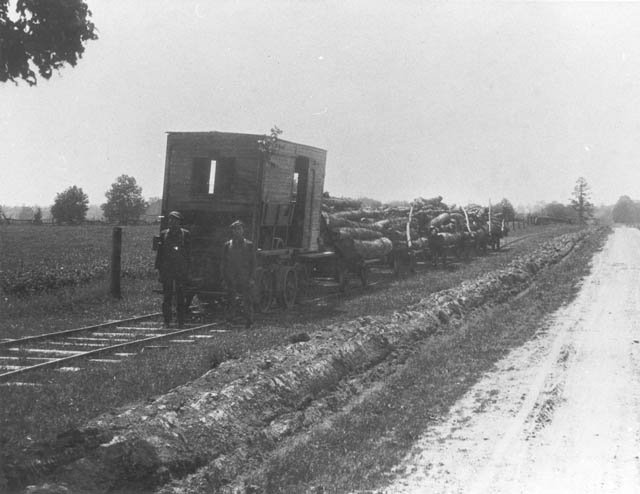Cargill Limited
Cargill
Brian
Westhouse

Peculiar
looking homemade engine. Note the strange middle
wheels!
Photo by John Boyd / GTR - CNR employee 1881 - 1931
The
logging operations carried on by Cargill Limited, Cargill Ont., in Bruce County,
are planned and carried out in a thoroughly modern manner. The company operate
in a mixed stand of hardwood and softwood in the Greenock swamp, practically all
of which is owned by Cargill Limited.
The skidding operations include
the use of a Ligerwood steam skidder which is mounted on a flat car woth a 40-foot
spar. Cables are run from the spar out into the bush 20 rods on each side of the
track and the logs are piled up 15 to 20 feet high along the track. All kinds
of logs are skidded together, incluging poles from 2 inches diameter up to the
largest logs. Nothing is left on the land but the brush and stumps.
The loading operations are handled by a steam log loader made by Cargill Limited.
This is also mounted on a short flat car. It has a 30-foot boom and will handle
about (estimated board measure) 1,000 feet to the lift in logs, or will load one
of the company's cars in three lifts of the largest logs, or smaller logs in a
sling. The log loader can also lift the logging cars off the track and pile them
up at a skidway. The ability of the loader to remove cars from the track permits
of it being kept on the main track all the time, following up the skidder. The
loader also has a device attached to the engine, so designed that when a car is
loaded, a line can be stretched out and the loaded car moved ahead very easily
without any loss of time. While this operation is going on the boom of the loader
is also swinging another car onto the track.
The logging locomotive operated
by Cargill Limited, is a standard gauge and is equipped with gasoline motive power,
thus removing all danger of fire in the swamp. The track is standard gauge of
35-lb. rails. The locomotive makes two trips a day, drawing 12 cars, which is
sufficient to keep the mill running continuously.
After the logs are
loaded on the cars in the bush by the loader they never again touch the ground.
They are unloaded in a sorting mill, which has tracks and conveyors running from
it in each direction and is so located that each block or log is delivered to
its proper place to be worked up into the finished product for which it is intended,
the whole process being completed without further handling.
Canada
Lumberman/Collection of Brian Westhouse
